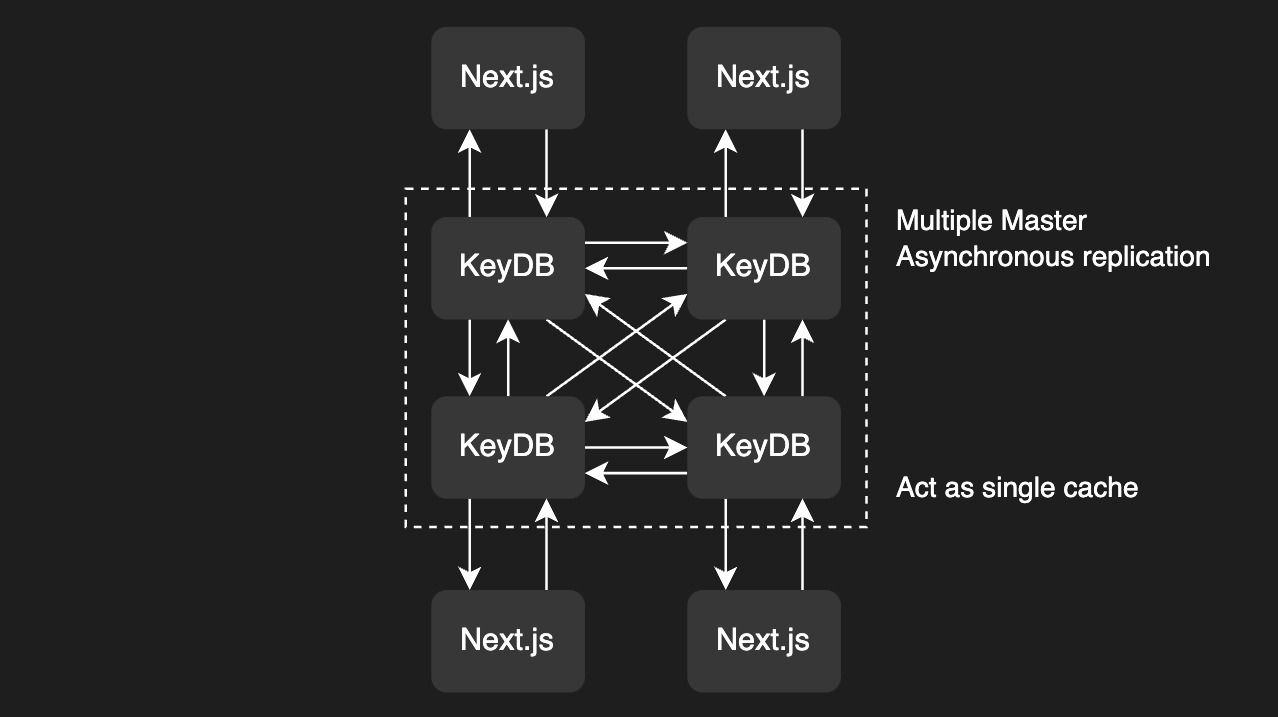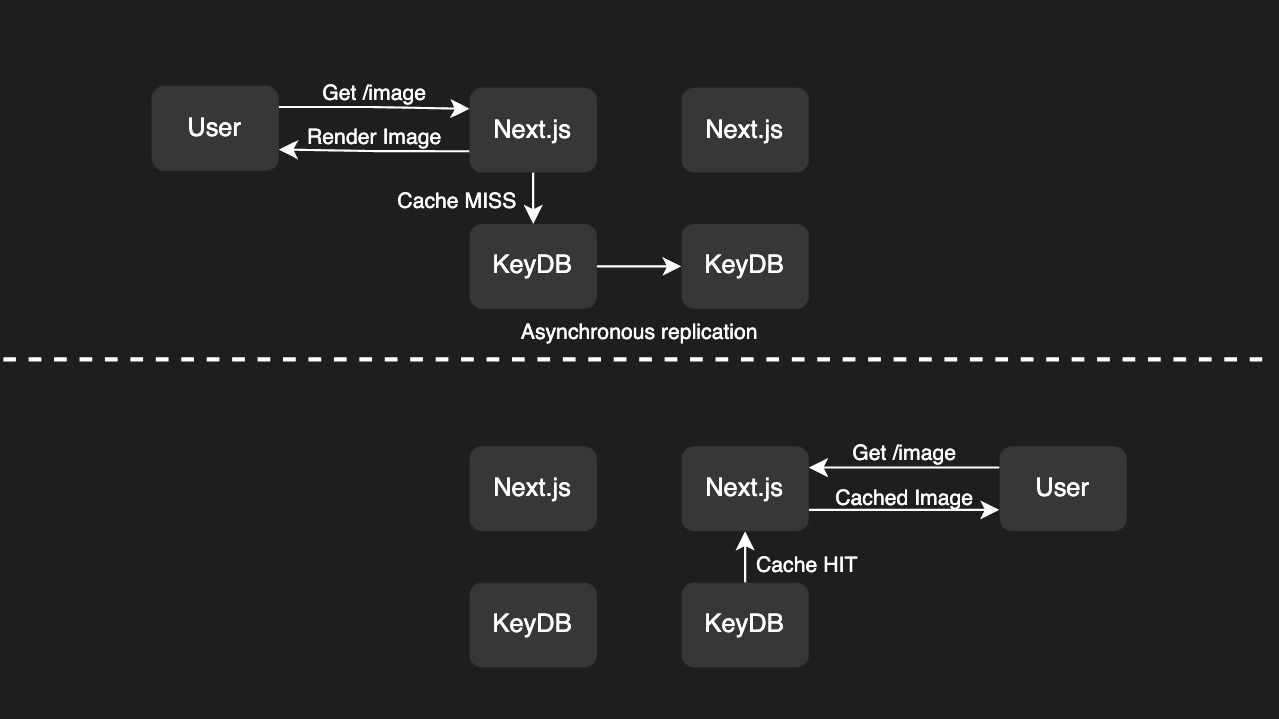Caching Next.js Image with KeyDB
2025-01-05

Jonathan Ho

We use Next.js execlusively for our website, on top of that, we use Next.js's Image component to optimize the image. To reduce size of the image, we use AVIF format, which is a modern image format that is more efficient than JPEG and WebP, but come with a cost of encoding time, it is much slower to encode an AVIF image than a WebP image. However, we found two issues that amplified by the AVIF format.
First, every time we push changes to the website (publish new container image and update the version in Coolify), the Next.js server would lost all it's cache, including the cache for optimized image. Therefore, when a user requests the image after an update, the server will need to re-encode or re-optimize all of the images, which takes time. Although, we can keep a docker volume for the cache, it is not ideal because of the Second issue.
Second, every server in our fleet would need to encode the image separately, which slow down the image loading and is a waste of resources. This is because the image is optimized at runtime, opposed to build time where the optimized image can be distributed with the container image. Not only that, the image cache is only stored in each of the server's own file system, which is not ideal because the cache is not shared between servers. Therefore, if the request is severed from a different server, the server would also need to re-render the image, because the rendered image only exists in other server's file system.
A Solution?
When searching for a solution, we found Next.js allow you to set a custom cache handler, which can use with conjunction with @neshca/cache-handler to use Redis as a shared cache. However, after some digging around, @neshca/cache-handler only support up to Next.js 14, and we are using Next.js 15, but that is not the main issue. The main issue is that the cache handler is not used to cache the optimized image, but to cache the fetched data and Incremental Static Regeneration page, which is not what we want.
Making own custom solution
Given the is no solution that fit our need, we decided to make our own custom solution. First, inspecting the Next.js's code for optimizing image, we located the file that is responsible for optimizing the image, which is server/image-optimizer.js. Base on that, we can have two ways to distribute the optimized image, first is to replicate the folder used to store the optimized image, and second is to store the optimized image directlly in Redis.
The first idea is to mount a distributed file system, i.e. GlusterFS, to the folder used to store the optimized image, so that the optimized image is shared between all servers. However, it add complexity to the infrastructure and it is unstable. Another idea is to asynchrously replicate the folder using Syncthing or another process, again the same issue with GlusterFS, it add complexity to the infrastructure. At last, we decided to store the optimized image in Redis, which is can be set up easily and can be use for other purpose, e.g. ISR cache with @neshca/cache-handler.
Database choice
Orginally, we planned to use Redis as the cache as it is the most popular in-memory database, with a lot of support and documentation. However, Redis does not support our use case. As recap, the architecture design of JH0poject's infrastructure is uniform and distributed across all servers to maintain high availability, which means that there is no centrallise cache server availabile. Therefore, we need a cache that is distributed across all servers, and every cache can be use for reading and writing. While, Redis support distributed cache via Replication, it use the master-replica model, where write need to go through master node (which can be located in another region). This is not ideal because it introduce latency for writing and single point of failure. Then we found KeyDB, which is a fork of Redis that supportmultiple master, which is what we need.

Modifying Next.js
Double checking the code in Next.js, making sure there is no way to implement using existing API, we decided to use yarn patch to do dependency patching at build time. In a nutshell, the patch configure Next.js store image as base64 string to KeyDB if a environment variable is set, and retrieve the image from Redis if found. A snippet of the code that is responsible for geting the cached image is as follow:
const file = await Promise.race([
this.redisClient.hgetall(cacheKey),
new Promise((r) => setTimeout(() => r(undefined), 1000))
]);
// Redis cache timeout or error
if (file === undefined) {
return null;
}
// Cache miss
if (Object.keys(file).length === 0) return null
const now = Date.now();
const {maxAge: maxAgeSt, expireAt: expireAtSt, etag, upstreamEtag, extension, buffer} = file;
const expireAt = Number(expireAtSt);
const maxAge = Number(maxAgeSt);
return {
value: {
kind: _responsecache.CachedRouteKind.IMAGE,
etag,
buffer: Buffer.from(buffer, "base64"),
extension,
upstreamEtag
},
revalidateAfter: Math.max(maxAge, this.nextConfig.images.minimumCacheTTL) * 1000 + Date.now(),
curRevalidate: maxAge,
isStale: now > expireAt,
isFallback: false
};
We added timeout for getting from the cache, since there's a 7 seconds limit for the server to respond to a image request, if we wait too long it will repsonse with a 500 error. This allow it to fallback to fetch upstream and optimize the image.

Together, it works like this. When a request for an image is made, the server will check if the image is in the KeyDB, if it is, it will return the image from KeyDB, if not, it will fetch the image from the upstream and optimize it, then store the optimized image in the KeyDB. KeyDB will asynchrously replicate the image to other servers, so that the image is available in all servers. Then when the image request land on another server, it able to retrieve the image from the KeyDB and return it to the user without re-optimizing the image.